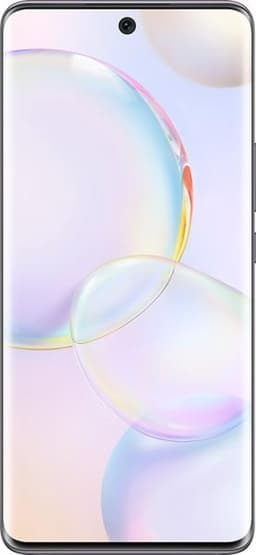- Archive
- Honor 50 review

Honor 50 review

The Honor Honor 50 ranks as the #273 phones globally, achieving a LibraScore of 63. Across all metrics, this product stands out most for its #310-ranked display among 800 phones. Consider the Honor 50 Pro or Honor Magic4, which offer higher scores while staying in the same price range.
Build Quality and Design
The Honor 50 features a sleek, lightweight glass design with a curved 6.57-inch OLED display framed by a 7.7mm-thin plastic chassis, offering a modern aesthetic without the premium weight of metal. Its 89% screen-to-body ratio enhances immersion, while the dual-edge curved glass and circular rear camera array add a refined, cohesive look. Available in multiple color options, the device balances elegance with practicality, though the plastic frame may feel less durable than metal alternatives. The build emphasizes slim dimensions (73.8mm width, 160mm height) and a 175g weight, ensuring portability without compromising on the premium visual appeal of its glossy materials. Honor Magic 3 might be a smarter choice, offering an upgraded design.
Battery Life
The Honor 50’s 4300mAh battery delivers all-day endurance, supported by a 100-hour endurance rating in testing. Its Li-Polymer cell pairs with 66W fast charging, replenishing the battery to 61% in just 30 minutes. While non-removable, the battery includes reverse charging for powering accessories. The device’s efficient power management, combined with the 120Hz display and optimized hardware, ensures prolonged usage without frequent recharging, making it ideal for heavy users prioritizing longevity and rapid recovery. For an improved battery, Honor 50 Pro is worth considering.
Display
The Honor 50 boasts a 6.6-inch curved OLED display with a 120Hz refresh rate and 392 PPI pixel density, delivering crisp visuals and fluid scrolling. Its FHD+ resolution (1080 x 2340 pixels) and 10-bit color depth ensure vibrant, lifelike hues, enhanced by DCI-P3 color gamut and precise touch sampling at 300 Hz. The 2.5D curved glass design not only elevates aesthetics but also offers ergonomic comfort during prolonged use. With a 19.5:9 aspect ratio and dual-edge curvature, the screen maximizes immersion for multimedia and gaming. Scratch-resistant and featuring always-on display, it balances performance with practicality, making it ideal for dynamic content consumption and interactive experiences. You might want to check out Honor 60, featuring an upgraded display for a superior experience.
Camera
The Honor 50’s camera system excels with a high-resolution main lens capturing vivid, detailed photos, supported by advanced features like 4K video recording and night mode for low-light clarity. Its quadruple rear setup includes a wide-angle lens for expansive shots, a macro lens for close-up creativity, and a secondary sensor for depth and zoom. The front-facing 32MP camera delivers sharp, well-lit selfies with natural skin tones. While optical stabilization is absent, digital image stabilization and phase detection autofocus ensure steady, focused results. The device’s AI enhancements refine colors and details, while manual controls let users adjust ISO, white balance, and exposure for creative flexibility. Whether shooting landscapes, portraits, or action scenes, the Honor 50 balances versatility and performance for everyday photography. Take a look at Honor 50 Pro - its improved camera sets a new standard.
Price and Value
The Honor 50 offers a compelling mid-range value proposition, balancing a high-resolution curved display, fast 66W charging, and a versatile quad-camera system with efficient Snapdragon 778G performance.
Performance
The Honor 50’s Qualcomm Snapdragon 778G (6nm) delivers efficient mid-range performance, handling multitasking and gaming smoothly with 6GB LPDDR5 RAM and 128GB UFS 3.1 storage. Its Adreno 642L GPU supports fluid graphics, while active cooling prevents overheating. Scoring 582,766 on Antutu, it outperforms 76% of devices, ensuring responsive daily use and stable app performance. The 66W fast charging complements its efficiency, making it a balanced choice for users prioritizing speed and reliability without premium-tier demands. It’s worth checking out Honor 80, delivering remarkable performance.
Pros
1. Sleek, curved OLED display with 120Hz refresh rate and vibrant color accuracy.
2. 66W fast charging ensures rapid battery replenishment for all-day use.
3. Versatile quad-camera system with 4K video, night mode, and AI enhancements.
4. Efficient Snapdragon 778G performance with 6GB LPDDR5 RAM for smooth multitasking.
5. Lightweight, slim design with 89% screen-to-body ratio for immersive viewing.
Cons
1. Plastic frame may feel less premium compared to metal or glass alternatives.
2. No optical image stabilization (OIS) for rear cameras, affecting low-light stability.
3. Snapdragon 778G mid-range processor may struggle with heavy gaming or intensive apps.
4. Lacks a headphone jack, relying solely on USB-C or Bluetooth audio.
5. No microSD slot, limiting storage expansion for budget-conscious users.
6. Front camera's 32MP resolution may result in larger file sizes and slower processing.
FAQ
Compare with other phones
See how this item stacks up against any other model
Choose two different items to see a detailed comparison of their specifications, performance, and features









